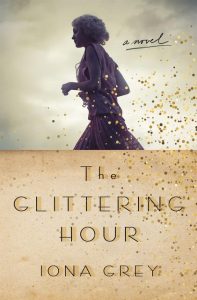What A Time To Be Alive
 ‘The past is a foreign country: they do things differently there.’
‘The past is a foreign country: they do things differently there.’
So begins The Go-Between by L.P. Hartley, one of my very favourite novels. Although the book is set in the swooning heat of high summer, it’s a line that always gives me goosebumps, and renews my frustration that time machines haven’t yet been invented so we can visit that place called The Past. In a world where celebrities and billionaires are booking their tickets to the moon, and even we mortals can circumnavigate the globe with ease and in comfort, the possibility of being able to make a trip back to Belle-Epoque Paris or the teeming streets of Victorian London seems tantalisingly conceivable.
And if some eccentric genius or real-life Doc Brown did emerge from a laboratory somewhere and announce that she’d cracked the time travel formula, I wonder how many of us would sign up? Full disclosure: I’m not the most adventurous traveller. My daughters happily wander off to places I can’t even pick out on a map, untroubled by anxieties about the heat, the insects or not knowing how to say ‘where is the nearest pharmacy’ in the relevant language, while all of those worries keep me closer to home, inside my comfort zone.
But the call of the past is strong and hard to resist, especially for writers of historical fiction. In this age of mindfulness, where living in the moment is the mantra, my thoughts are constantly sliding away from the present and sneaking out of the back door to the past, hoping to catch a glimpse of the people who lived there and hear their voices, longing to walk alongside them and see the world that they saw.
I like to think I’d be at the front of the queue to book my seat; after all, it’s this longing – this curiosity – that drives me to write in the genre that I do. But I’ve spent the last couple of years writing a book that was based on my grandmother’s experience, and it has shone a harsh light on my soft-focus fantasies about the past, and given me more of a visceral understanding of the reality of life, particularly for women, in the generations that went before ours.
Intellectually, of course, we all know that for most of history being a woman was no walk in the park. (Indeed, for much of history walking in the park alone would have been strictly forbidden for half the female population, and simply out of the question on account of the demands of domestic life for the other half.) In fact, that statement is so glaringly obvious, so universally acknowledged, that it has lost much of its bite, and I wonder if we historical authors might bear some small responsibility for that? Good fiction, compelling stories, are built around struggle, adversity and conflict.
As readers we love to see characters face hardship and injustice and find ways to overcome them, and as writers we instinctively follow Nabokov’s advice to put our protagonist up a tree and throw rocks at him. (Of course, Nabokov naturally assumed the protagonist would be male…) History obligingly offers us a wealth of opportunities to throw rocks at our female characters without having to make anything up at all.
We are spoiled for choice when it comes to scenarios of female marginalisation, disempowerment, oppression and silencing, and plots containing physical and sexual violence against women, abuse and coercive control are sadly all too plausible.
I have written those scenes myself, and felt sorrow, compassion, frustration and fury on behalf of my characters. And yet, it was only when I wrote a story based on my own grandmother’s quiet, commonplace tragedy that I really glimpsed what that disempowerment and silencing might actually have felt like, because I understood the profound impact of those things and the way their ripples spread out through a family, and down through the years.
My first historical novel, Letters to the Lost, was set in WW2; an era I felt a great connection to, thanks to the family stories I grew up hearing and the fiction I read. The starting point for my second book was not seismic events that shook the world, but devastation on a smaller, more personal scale.
The events of my mother’s childhood were all too familiar to me, but as I worked through them as I writer I began to see them differently. I had been used to viewing the story from my mother’s perspective, identifying with the pain and bewilderment of the little girl, but for the first time my focus shifted to her mother, the grandmother I had never known, and the narrative took on a more universal aspect.
I understood that what she endured was not just a personal misfortune, but part of a bigger picture. A picture in which women’s lives were smaller than men’s, their experiences less important, their voices less audible. A picture in which women, by definition, were simply less.
The enormity of this injustice, and the overwhelming odds stacked against women exerting their autonomy, struck me properly for the first time, like a blow to the stomach. It ceased being something I knew about in an abstract, academic sense, and become something real and personal and raw.
And so, when that eccentric genius scientist unveils their real-life time-travelling DeLorean I’m no longer sure I’ll be leading the stampede for a seat in it. My fascination with the past remains as strong as ever, but my rose-tinted glasses have been knocked off and broken.
The past is a foreign country. They do things differently there.
Thank goodness.
—
Iona Grey has a degree in English Literature and Language and a lifelong fascination with history, particularly the lives and experiences of women in the past. She lives in rural Cheshire, in the North-West of England, with her husband and whichever of her three almost-grown-up daughters happens to need laundry doing. Her second novel, The Glittering Hour, is out with St Martins Press in December 2019 and she is currently hard at work on a third.
 An unforgettable historical about true love found and lost and the secrets we keep from one another from an award-winning author
An unforgettable historical about true love found and lost and the secrets we keep from one another from an award-winning author
Selina Lennox is a Bright Young Thing. Her life is a whirl of parties and drinking, pursued by the press and staying on just the right side of scandal, all while running from the life her parents would choose for her.
Lawrence Weston is a penniless painter who stumbles into Selina’s orbit one night and can never let her go even while knowing someone of her stature could never end up with someone of his. Except Selina falls hard for Lawrence, envisioning a life of true happiness. But when tragedy strikes, Selina finds herself choosing what’s safe over what’s right.
Spanning two decades and a seismic shift in British history as World War II approaches, Iona Grey’s The Glittering Hour is an epic novel of passion, heartache and loss.
Category: Contemporary Women Writers, How To and Tips






























